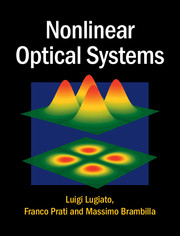Book contents
- Frontmatter
- Dedication
- Contents
- Preface
- Part I Models, propagation, stationary phenomena
- Part II Dynamical Phenomena, Instabilities, Chaos
- Part III Transverse optical patterns
- 26 Gaussian beams and modes of cavities with spherical mirrors
- 27 General features about optical pattern formation in planar cavities
- 28 The Lugiato-Lefever model
- 29 Spatial patterns in cavities with spherical mirrors
- 30 Cavity solitons
- Appendix A The Routh–Hurwitz stability criterion
- Appendix B Calculation of the oscillatory instability boundary
- Appendix C Coefficients of the characteristic equation (20.20)
- Appendix D Derivation of equations (20.27) and (20.28)
- Appendix E Coefficients of equations (20.60) and (20.61)
- Appendix F The exact boundary of the Risken–Nummedal–Graham–Haken instability
- Appendix G Nonlinear analysis of the roll solution
- References
- Index
26 - Gaussian beams and modes of cavities with spherical mirrors
from Part III - Transverse optical patterns
Published online by Cambridge University Press: 05 March 2015
- Frontmatter
- Dedication
- Contents
- Preface
- Part I Models, propagation, stationary phenomena
- Part II Dynamical Phenomena, Instabilities, Chaos
- Part III Transverse optical patterns
- 26 Gaussian beams and modes of cavities with spherical mirrors
- 27 General features about optical pattern formation in planar cavities
- 28 The Lugiato-Lefever model
- 29 Spatial patterns in cavities with spherical mirrors
- 30 Cavity solitons
- Appendix A The Routh–Hurwitz stability criterion
- Appendix B Calculation of the oscillatory instability boundary
- Appendix C Coefficients of the characteristic equation (20.20)
- Appendix D Derivation of equations (20.27) and (20.28)
- Appendix E Coefficients of equations (20.60) and (20.61)
- Appendix F The exact boundary of the Risken–Nummedal–Graham–Haken instability
- Appendix G Nonlinear analysis of the roll solution
- References
- Index
Summary
In this chapter we describe the case of a free electric field that does not interact with any material, so we start from Eq. (3.30) with the atomic polarization P0 set equal to zero. In addition, we focus on the stationary solutions, hence we drop also the term with the time derivative, and the transverse Laplacian plays the crucial role in determining the field configuration.
In Section 26.1 we show that the field equation admits stationary solutions in which the field has a Gaussian configuration with a beam radius (equal to the halfwidth of the Gaussian) that varies as a function of the longitudinal coordinate z, and that the variation is governed by a parameter, called the Rayleigh length, which characterizes the diffraction of the beam. The Gaussian solution corresponds to the fundamental mode of the radiation field, and the plane-wave solutions constitute a limit case of the Gaussian solutions obtained when the beam radius tends to infinity.
On the other hand, in Section 26.2 we derive the higher-order modes, in the form of Gauss-Hermite modes, given by the product of the fundamental Gaussian mode and Hermite polynomials, and Gauss–Laguerre modes, given by the product of the fundamental Gaussian mode and Laguerre polynomials. The Gauss–Hermite modes are appropriate to treat problems with square symmetry; the Gauss–Laguerre modes are appropriate to treat problems with axial symmetry. In both cases the modes depend on one independent parameter, the Rayleigh length, and in both cases the modes constitute an orthonormal and complete set of functions of the transverse variables x and y for any arbitrary value of the longitudinal variable z.
Sections 26.3–26.5 are devoted to the case of Gaussian modes in a cavity. To be precise, in Section 26.3 we focus on the case of a Fabry–Perot cavity with spherical mirrors and calculate the Rayleigh length which characterizes the set of cavity modes as a function of the parameters of the cavity, i.e. the radii of curvature of the spherical mirrors and the distance between the mirrors.
- Type
- Chapter
- Information
- Nonlinear Optical Systems , pp. 323 - 341Publisher: Cambridge University PressPrint publication year: 2015

